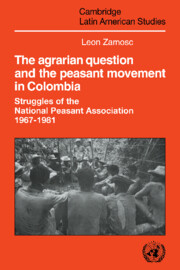 The Agrarian Question and the Peasant Movement in Colombia
The Agrarian Question and the Peasant Movement in Colombia Book contents
- Frontmatter
- Contents
- List of tables, figures, and maps
- Foreword by Tedor Shanin
- Foreword by UNRISD
- Acknowledgments
- List of abbreviations
- Map 1 Republic of Colombia
- Introduction
- 1 The agrarian question in Colombia
- 2 Reformism and the beginnings of the peasant movement
- 3 The radicalization of ANUC and the great waves of land invasions
- 4 Counterreform
- 5 The contradictory influences of peasant politicization
- 6 Concessions and repressive escalation
- 7 The new occupational alternatives and the issue of the rural proletariat
- 8 Partial repeasantization and the question of the new peasant settlements
- 9 Final crisis and clientelist regression of ANUC
- 10 Overview and final remarks
- Notes
- Bibliography
- Index
- Cambridge Latin American Studies
10 - Overview and final remarks
Published online by Cambridge University Press: 10 October 2009
- Frontmatter
- Contents
- List of tables, figures, and maps
- Foreword by Tedor Shanin
- Foreword by UNRISD
- Acknowledgments
- List of abbreviations
- Map 1 Republic of Colombia
- Introduction
- 1 The agrarian question in Colombia
- 2 Reformism and the beginnings of the peasant movement
- 3 The radicalization of ANUC and the great waves of land invasions
- 4 Counterreform
- 5 The contradictory influences of peasant politicization
- 6 Concessions and repressive escalation
- 7 The new occupational alternatives and the issue of the rural proletariat
- 8 Partial repeasantization and the question of the new peasant settlements
- 9 Final crisis and clientelist regression of ANUC
- 10 Overview and final remarks
- Notes
- Bibliography
- Index
- Cambridge Latin American Studies
Summary
The land struggles of the 1970s were part of a broader offensive aimed at forcing a change that would favor a peasant path of agrarian evolution in Colombia. The challenge to the existing structure of land property, which became the most advanced battlefront of the peasant movement, was rooted in the earlier peasant mobilizations of the twentieth century and developed as a continuation of many local and regional conflicts that had arisen since the 1960s. With the emergence of ANUC as an integrative force at the national level, the land struggles intensified and were articulated into a unified thrust encouraged by the state and bourgeois reformism. With the increasing tensions due to the accelerated dissolution of precapitalist relations of production and the wave of disputes over unused and public lands, the defeat of reformism within the ruling coalition precipitated the confrontation between the usuarios and the new counter-reformist policies of the state. The land invasions during 1971 climaxed the struggle for land, played a crucial role in the radicalization of the peasant movement, and gave many peasants access to the land.
However, the peasant offensive failed to become an agrarian revolution capable of breaking the power of the landowners and creating a social and economic structure favoring the peasantry. The battles developed in those places in which there were sharper contradictions and more favorable conditions for mobilization at the grass-roots level.
- Type
- Chapter
- Information
- The Agrarian Question and the Peasant Movement in ColombiaStruggles of the National Peasant Association, 1967–1981, pp. 202 - 214Publisher: Cambridge University PressPrint publication year: 1986
